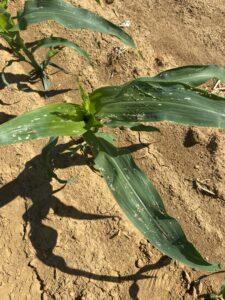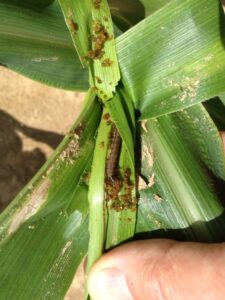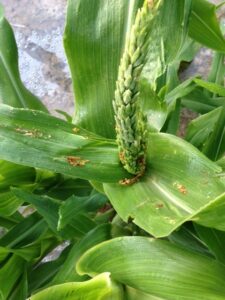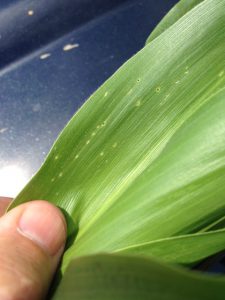Sweet Corn
European corn borer (ECB) moth catches are very low and scattered among blacklight traps in the northern and central counties. Larvae are absent from whorl and pre-tassel stage plantings. Should numbers rebound later in the summer, they will be reported in table form.
Fall armyworm (FAW) infestations are low and inconsistent in scouted fields north of Burlington County. At this time, field technicians are occasionally encountering small clusters of infested whorl stage plants, indicating that individual moths had entered fields and deposited eggs. Cooperating growers in Cape May County (where FAW is typically heaviest) report that FAW has thus far been largely absent from fields. Moths are showing up in blacklight traps occasionally, with slightly more individuals in coastal county sites. Because FAW moths are highly mobile, and with southerly winds dominating our weather lately, it is important to monitor fields at least weekly for signs of infestation. Whorl stage plants are prime targets for egg laying.
 Newly hatched FAW larvae cause holes and scratches on leaves that are similar to ECB feeding, except that they tend to be more concentrated and always lead down into the whorl (see photo at left). As the larvae grow, the feeding becomes more destructive, with large ragged holes and obvious droppings deposited in the whorl (see photo at right).
Newly hatched FAW larvae cause holes and scratches on leaves that are similar to ECB feeding, except that they tend to be more concentrated and always lead down into the whorl (see photo at left). As the larvae grow, the feeding becomes more destructive, with large ragged holes and obvious droppings deposited in the whorl (see photo at right). 
We will provide updates on new FAW appearances and severity as reports come in. FAW are resistant to synthetic pyrethroids. Effective sprays should include IRAC grp. 5 (spinosyns) or IRAC grp. 28 (diamides). The carbamate (IRAC grp. 1A) Lannate is also still effective. Sufficient water should be used in the applications to allow the solution to penetrate the layer of droppings that may have formed above the caterpillar.
 Articles in this section contain information helpful to the NJ commercial organic grower.
Articles in this section contain information helpful to the NJ commercial organic grower.


